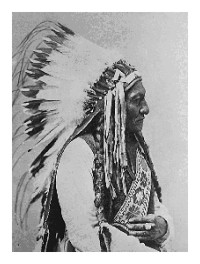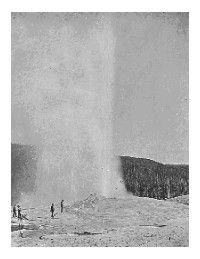Click here to Sponsor the page and how to reserve your ad.
-
Timeline
1875 - Detail
November 9, 1875 - Reporting on the Indian Wars, inspector E.C. Watkins pronounces that hundreds of Sioux and Cheyenne under Indian leaders Sitting Bull and Crazy Horse are openly hostile against the United States government, forming U.S. policy over the next year that would lead to battles such as Little Big Horn.

He had a lot to say, this Edwin (sometimes Erwin) Watkins in his report as an inspector for Indian Affairs. This was despite suggestions that despite his traveling through Indian territory and meeting with the various tribes in what had seemed peaceable circumstances since 1874, and that he had not really seen the offenses asserted against Chief Sitting Bull and Crazy Horse of the Lakota Sioux, or the Cheyenne, as many of the Indian Wars were yet to come. So what would have prompted such a report. Was it a push from his superiors and a rationale for war against the tribes aforesaid mentioned? The government lied. Surely that could not be the case.
Let's get some background to the Black Hills and the rights of the Lakota Sioux to that territory. First, they were ceded the land in the Treaty of Fort Laramie in 1868, as well as hunting rights in nearby states and territories. However, six years later, General George Armstrong Custer was sent into South Dakota with one thousand troops. It was July and his order had come directly from President Ulysses S. Grant. His mission, however, was not an acrimonious one, at least at first. He was to scout for a site to build a fort. Unfortunately, there were two prospectors in his entourage, also sent by Grant, and they went hunting for gold. Finding it, the Black Hills were seen as a way out of the 1873 depression. A reporter, William E. Curtis, from the Chicago Inter Ocean, with the group as well, noted in the paper, "From the grass roots down it was pay dirt." The national papers ran with the story; suddenly there were one thousand miners in the Black Hills. Guess we can see the problem with that. It was not their land. It was owned, by treaty, by the most fierce tribe in the west, the Lakota Sioux. And most had settled within that land, the Great Sioux Reservation which surrounded and included the Black Hills. Only about one thousand had rejected living the white farming lifestyle and preferred to remain nomadic.
Western businessmen hounded Grant to annex the land, placing Ulysses in a quandry. He had always preferred a peace plan with the Indian nations and assimilation into white culture, not war. And he had no legal reason to annex the Black Hills. However, there were ways to change the narrative and make annexation seem much more palatable to the public. His corrupt cabal would hatch a plan; Grant would go along with it. In May 1875, representatives of the tribes came to Washington, D.C. to meet with Grant over a lack of rations and complain about the miners. Grant stated he could not control the miners; which was true, and that the treaty obligations concerning rations could be revoked. He essentially gave them the ultimatum, ... give up the land or lose their rations. They left with no agreement.
General George Crook was in charge of expelling the miners, but was sympathetic toward them. He suggested they record their claims for the time in the future when the land was U.S. owned again. He also admitted that the Lakota had not been a problem, not been starting conflicts. Grant decided to hold a second conference in the Black Hills, appointing a commission to negotiate the sale of mineral rights. They met in September 1875. Sitting Bull did not come; neither did Crazy Horse. The chiefs who attended did not want to sell, and were told, even if they did, the offer was too low.
By October, President Grant had ordered General Philip Sheridan to cut short his honeymoon and come back to Washington. Sheridan, under Sherman, was head of the Department of the West. While Grant told pastors and others who preferred the Peace Plan, he was putting together a group that would head in the opposite direction. On November 3, 1875, a war plan was devised. His allies were General Crook and Sheridan, Secretary of War William Belknap, plus more. General Sherman was not there, nor agreed. Despite their Civil War friendship, it had soured during Grant's administrations. In the meeting, Grant stated that the Lakota should go the reservation or be whipped. Now his rationale needed a firm, if untrue, basis, so a non-descript Indian agent helped Grant get his wish.
E.C. Watkins Report
United States Indian Inspector E. C. Watkins gave this report of his travel through Indian territory to the Commissioner of Indian Affairs on November 9, 1875. He had served in the Civil War under General Sheridan and General Crook.
"I have the honor to address you in relation to the attitude of certain wild and hostile bands of Sioux Indians in Dakota and Montana that came under my observation during my recent tour through their country, and what I think should be the policy of the Government toward them. I refer to Sitting Bull's band and other bands of the Sioux Nation under chiefs or head-men of less note, but no less untamable and hostile. These Indians occupy the center, so to speak, and roam over Western Dakota, and Eastern Montana, including the rich valleys of the Yellowstone and Powder Rivers, and make war on the Arickarees, Mandans, Gros Ventres, Assinaboines, Blackfeet, Piegans, Crows, and other friendly tribes on the circumference. From their central position they strike to the East, North, and West, steal horses, and plunder from all the surrounding tribes, as well as frontier settlers and luckless white hunters or emigrants who are not in sufficient force to resist them ..."
"... The true policy, in my judgment, is to send troops against them in the winter, the sooner the better, and whip them into subjection. They richly merit punishment for their incessant warfare, and their numerous murders of white settlers and their families, or white men wherever found unarmed."

Great Sioux War of 1876 to 1877
A thousand man Army was suggested to take up the task. Meanwhile former Michigan Senator, and now Interior Secretary, William Chandler sent out an ultimatum; all Lakota must be on the reservation by December 31, 1876 or they would be considered hostile. The Lakota, settled for the winter by then, said they would discuss further in the spring. Chandler wanted action by January 31, 1876.
February 8, 1876 - General Terry and General Crook were ordered to begin the campaign. Winter weather hindered Terry.
March 17, 1876 - General Crook's Lieutenant, Colonel Joseph J. Reynolds attacked a village of sixty-five lodges, thinking Crazy Horse and the Lakota were there. However, it was a peaceful group of Cheyenne who were attacked by mistake, though they drove back the Army. Reynolds was court-marshaled for his actions.
June 17, 1876 - Battle of the Rosebud. Crook, although he claimed victory, was fought to a standstill, then retreated.
June 25, 1876 - Battle of Little Bighorn. Complete destruction of General Custer's troops, including some of General Terry's in surprise attack. No United States soldiers survived. This disaster, while a Native victory, increased the desire of the U.S. Army and President Grant to complete the mission and would lead to the end of the free-roaming tribes.
September 9, 1876 - Looking for food, General Crook attacked the small village of Slim Buttes, before being engaged by Crazy Horse in a counter-attack the next day. It was repulsed.
November 25, 1876 - Dull Knife Fight against the Cheyenne in Wyoming by Colonel Ranald S. Mackenzie and his Fourth Cavalry lead to the Cheyenne's surrender.
January 8, 1877 - Colonel Nelson Miles fights the Battle of Wolf Mountain in southern Montana against Crazy Horse and Two Moon. Deep snow stopped the fight, ending in a draw. Even though a draw, the Lakota and Cheyenne leaders could see that they were unsafe even in winter.
May 6, 1877 - Crazy Horse and his surviving members, one thousand and one hundred strong, surrender to the U.S. Army at Camp Robinson. Some of the northern tribes escape to Canada.
Photo above: Photo of Chief Sitting Bull, 1884, Palmquist & Jurgen. Courtesy Library of Congress. Photo below: Crazy Horse Design Sculpture with Memorial in Background, 2024, America's Best History. Info Source: "Native History: Indian Agent Report Leads to Great Sioux War," 2018, Alysa Landry, ictnews.org; "Major E. C. Watkins - Frustrating Adventure: Defining Family in the Post-Civil War North American West," 2013, Anne Hyde, American Historical Association; "Ulysses S. Grant Launched an Illegal War Against the Plains Indians, Then Lied About It," 2016, Peter Cozzens, Smithsonian Magazine; Reports of the Indian Commission to the War Department, Senate Records; Wikipedia Commons.






